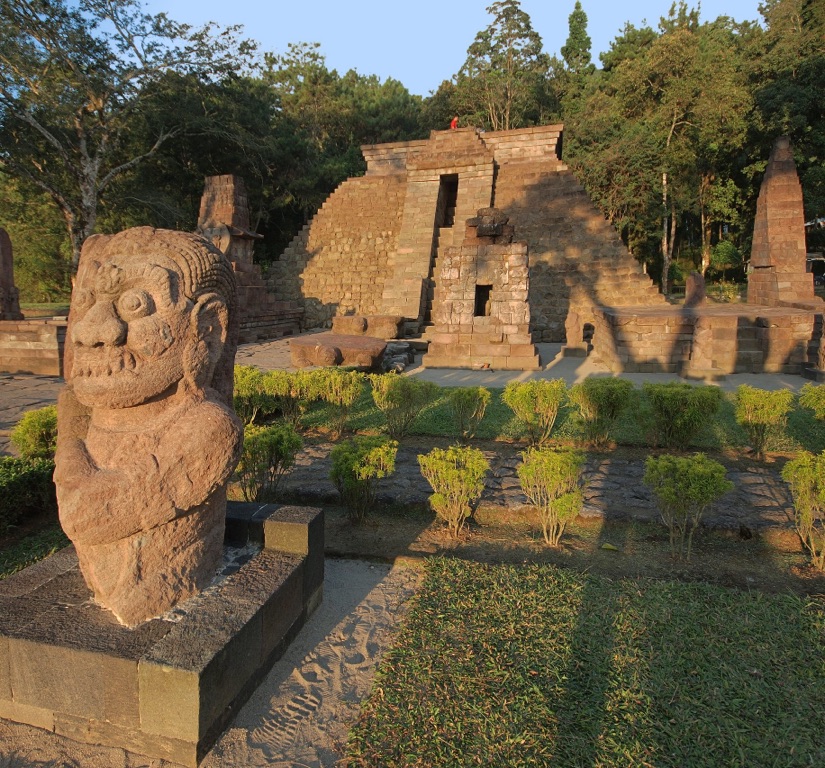Step into the enigmatic realms of Candi Sukuh, a unique Hindu temple situated on the slopes of Mount Lawu in Central Java, Indonesia. This fascinating monument stands out for its pyramidal structure, reminiscent of ancient Latin American architecture. Unlike the typical sharp spires of Javanese temples, Candi Sukuh’s truncated form and unmistakable themes of life and fertility offer a glimpse into a distinctive blend of Indonesian and ancient animist beliefs. Visitors are greeted by a series of reliefs and statues that depict various symbols and rituals, possibly linked to pre-Hinduism practices, making it a treasured asset for cultural aficionados and historians alike.
Majapahit Empire
The Majapahit Empire, one of the most powerful maritime empires in Southeast Asian history, flourished from the late 13th century to the early 16th century AD. Its inception can be traced back to 1293 AD, when Raden Wijaya, the founder of the empire, established his rule after defeating the Mongol invaders sent by Kublai Khan. This victory not only marked the beginning of the Majapahit era but also symbolized the resilience and military prowess of the Javanese people.
At its zenith, under the reign of King Hayam Wuruk (1350-1389 AD) and his prime minister, Gajah Mada, the Majapahit Empire’s influence extended over much of present-day Indonesia, parts of Malaysia, and beyond. The empire’s territorial expansion was largely due to Gajah Mada’s ambitious campaign, the Palapa Oath, which aimed to bring the surrounding archipelago under Majapahit suzerainty. This period is often regarded as the golden age of Javanese civilization, characterized by significant achievements in art, culture, and trade.
The Majapahit society was intricately hierarchical, with a sophisticated court system that reflected Hindu-Javanese culture. Hinduism, alongside Buddhism, was the predominant religion, influencing the empire’s art, architecture, and literature. The Candi of Trowulan, the empire’s capital, is a testament to Majapahit’s architectural grandeur, featuring intricate carvings and bas-reliefs depicting Hindu mythology.
Daily life in the Majapahit Empire varied significantly between the social classes. The ruling elite and nobility enjoyed a life of luxury and leisure, engaging in sophisticated courtly pursuits such as literature, music, and dance. In contrast, the commoners, who were mainly farmers, fishermen, and traders, led simpler lives, with their daily routines revolving around agriculture and commerce. The bustling ports of the empire were hubs of international trade, connecting the archipelago with the wider world, including China, India, and the Middle East.
The empire’s decline began in the early 15th century, following internal conflicts and the death of King Hayam Wuruk. Successive rulers failed to maintain the vast territories and political influence of their predecessors. The rise of Islam in the Indonesian archipelago further weakened the Hindu-Buddhist Majapahit, leading to its gradual disintegration. By the early 16th century, the once-mighty empire had fractured into smaller, Islamic sultanates, marking the end of Hindu-Buddhist dominance in the region.
Throughout its history, the Majapahit Empire was ruled by a succession of kings and queens, each contributing to the empire’s legacy in various ways. Notable rulers include Queen Tribhuwana Wijayatunggadewi, who expanded the empire’s territories, and King Hayam Wuruk, under whose reign the empire reached its cultural and territorial zenith. These rulers were not only political leaders but also patrons of the arts, significantly contributing to the cultural richness of the Majapahit era.
The empire was also known for its military prowess, engaging in numerous wars and battles to expand and defend its territories. The naval expeditions led by Gajah Mada are particularly noteworthy, showcasing the empire’s naval strength and strategic capabilities. These military campaigns were crucial in establishing Majapahit’s dominance in the region and securing its trade routes.
In conclusion, the Majapahit Empire stands as a monumental chapter in Southeast Asian history, remembered for its cultural achievements, architectural wonders, and significant influence on the region’s political landscape. Its legacy continues to be celebrated in Indonesia and beyond, symbolizing a golden age of Javanese civilization and the enduring spirit of its people.

